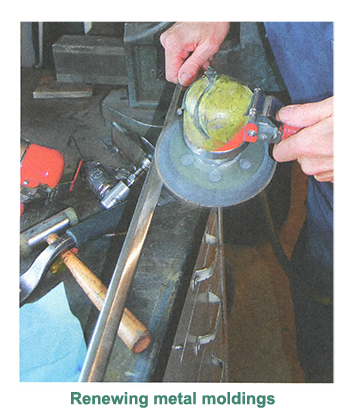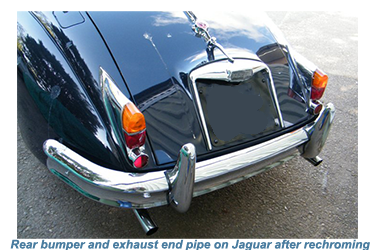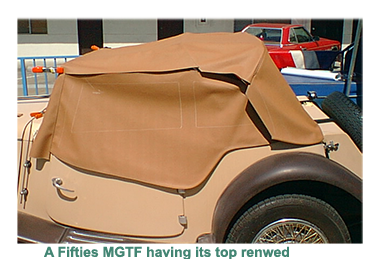
 The icing on the cake for any restoration project is completing the vehicle's external trim.
The icing on the cake for any restoration project is completing the vehicle's external trim.
 Restoring the exterior trim is easier said than done for the average restorer due to the significant variations of metal and materials involved calling for specialist skills and tools.
Restoring the exterior trim is easier said than done for the average restorer due to the significant variations of metal and materials involved calling for specialist skills and tools.
To begin with, classic cars produced in the UK and Europe during the late-Fifties and all through the Sixties stood out for their shiny chrome exterior trim- and lots of it.
Influenced by trends in the USA, larger-scale family saloons and most sports cars were garnished with chrome. Even though the material used to produce chrome, steel, aluminium, copper and zinc alloys was in short supply during the Fifties.
Despite the shortages and the costs, after the austere designs of the immediate post-war years, the public hungered for chrome and were prepared to pay for it.
Now Fifty or Sixty years on, the restorer will be required to meet the bill again to restore their car to its former glory.
Chrome trim is not as prone to rusting as metal, although it will have become faded and dull over the years, losing its eye appeal and charm.
Unfortunately, the only way to bring a vehicle's chrome trim back to its best is to have it re-plated, a procedure that can only be left in specialist's hands.
Finding a reliable company that provide chrome plating services will take some research and probably a little travel, as early as possible as these companies are not located on every street corner these days.
![]()
Once a chrome plating company that looks like they might fit the bill has been sourced, most restorers find it most efficient to pay them a visit, complete with all the items needed to be replated and get a real-time estimate of costs well as time scales.
If the plating shop are reasonable people who can be trusted, some of the expense of chrome plating can be reduced by determining if certain parts do not need replating and can be brought back to their shiny best with a simple buffing.
 External parts missing will need to be replaced, although most replacement exterior trim parts can be found online, as long as the model is not totally obscure.
External parts missing will need to be replaced, although most replacement exterior trim parts can be found online, as long as the model is not totally obscure.
Although there are several more up to date methods that are often less expensive than chrome plating, it still remains the finish of choice for most professional car restorers.
Another essential facet of an exterior trim renovation is to examine the state of the vehicle's glass to see if it is salvageable.
Once again, if the target vehicle has been used, even infrequently, then the glass and the rubber seals keeping it in place should be in roadworthy condition.
In the more likely situation where the vehicle has been in storage, then the chances are that the glass will be cracked, pitted, or the surface has delaminated.
![]()
Glass for cars, no matter their age, can be easily sourced, although problems can arise when sourcing rubber seals. Any professional auto-glazier can help but it should take a long time to find the appropriate rubber stripping.
If the glass is not in bad shape but a little lifeless, then a minor investment in a professional glass polishing kit and lots of elbow grease should see the glass back to its glistening best.
Anyone with a sure set of hands with access to a simple power drill will be able to remove light scratches and shallow pits from the windshield.
 Car manufacturers of the Fifties and Sixties were much more inclined to go for shorter production runs than they do today, meaning that even the most popular models remained in production for just three of four seasons, a situation that would be unheard of today.
Car manufacturers of the Fifties and Sixties were much more inclined to go for shorter production runs than they do today, meaning that even the most popular models remained in production for just three of four seasons, a situation that would be unheard of today.
 Because of their ability to produce cars in short production runs, UK and European car manufacturers were inclined to indulge themselves by creating design variations of their better selling saloon models.
Because of their ability to produce cars in short production runs, UK and European car manufacturers were inclined to indulge themselves by creating design variations of their better selling saloon models.
One of these variations was the soft top, where leading UK manufacturers' in particular released a number of soft-topped family saloons in addition to the open-top tourers that so typified UK manufacturers in the period between the wars and were especially popular during the Sixties.
Despite often unpredictable weather, soft tops were steady sellers during those years. Because they are more susceptible to the passing of time, soft tops have become increasingly scarce and thus valuable collector's items.
![]()
Anyone brave enough to consider acquiring and restoring a soft-topped vehicle must assume that this is a job for specialists only.
If the top has never been renewed during its time on the road, the chances are that even the basic frame has been ruined, and the whole apparatus needs to be changed, and more likely the fabric top. An expensive and time-consuming process.
Another of the more obscure design concepts still available during the Fifties and Sixties were estate cars adorned with a wooden exterior frame.
The concept derived from the famous Woody station wagons, commonplace in the United States during the Thirties to Fifties.
 The idea was less widespread in the UK and Europe. The only major manufacturer that offered such a model was Morris, with their Mini, Minor, and the larger Oxford Traveller version.
The idea was less widespread in the UK and Europe. The only major manufacturer that offered such a model was Morris, with their Mini, Minor, and the larger Oxford Traveller version.
Any car restorer who manages to acquire these models, with the Oxford being the rarest, will face the interesting challenge of renewing most of the frame.
 These attractive frames were rapidly found to be incapable of bearing the brunt of British winters and need to be changed regularly.
These attractive frames were rapidly found to be incapable of bearing the brunt of British winters and need to be changed regularly.
Experienced restorers will tell you that going through the external restoration process can be a bittersweet experience.
On the one hand, they will probably have played very little active part in this vital stage of the entire restoration. On the other hand, all they have had to do is reach for their chequebook and pay out some hefty bills.
However, the end result will have been more than worth it.
ex5


